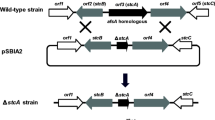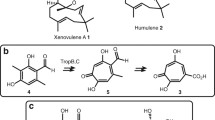Abstract
Recent work on the aflatoxin biosynthetic pathway is reviewed, with special emphasis on the enzymes of the late stages of the pathway involving conversion of sterigmatocystin (ST) to aflatoxin B1 (AFB1) through an O-methylsterigmatocystin intermediate. Two enzyme activities were discovered in subcellular fractions of cell-free extracts of a mutant strain ofAspergillus parasiticus (SRRC 163): 1)A post-microsomal methyltransferase (MT) catalyzed conversion of ST to OMST, and 2) a microsomal-associated activity (oxido-reductase) converted OMST to AFB1. The 168 KDa, anionic MT was purified to homogeneity and characterized (two subunits, 110 KDa and 58 KDa). Preliminary evidence indicated the presence of a cationic isozyme of the MT in mycelial extracts. The oxido-reductase has been partially purified and characterized. Polyclonal antibodies were prepared to the anionic MT and the enzyme's amino acid composition determined. A cDNA library has been constructed from mRNA isolated fromAspergillus parasiticus mycelia during the onset of AFB1 biosynthesis for the purpose of identifying the genes responsible for aflatoxin biosynthesis.
Similar content being viewed by others
References
Benasutti M, Ejadi S, Whitlow MD, Loechler EL. Mapping the binding site of aflatoxin B1 in DNA: Systemic analysis of the reactivity of aflatoxin B1 with guanines in different DNA sequences. Biochemistry 1988; 27: 472–81.
Bennett JW, Christensen SB. New perspectives on aflatoxin biosynthesis. Adv Appl Microbiol 1983; 19: 53–92.
Bennett JW, Lee LS. Mycotoxins — their biosynthesis in fungi: aflatoxins and other bisfuranoids. J Food Protec 1979; 42: 805–9.
Bennett JW, Lee LS, Shoss SM, Boudreaux GH. Identification of averantin as an aflatoxin B1 precursor: Placement in the biosynthetic pathway. Appl Environ Microbiol 1980; 39: 835–9.
Bhatnagar D, Cleveland TE. Fate of the methyl group during the conversion of sterigmatocystin into O-methylsterigmatocystin and aflatoxin B1 by cell-free preparations ofAspergillus parasitions. Biochimie 1988; 743–7.
Bhatnagar D, Cleveland TE, Lax AR. Comparison of the enzymatic composition of cell-free extracts of non-aflatoxigenicAspergillus parasiticus with respect to late stages of aflatoxin biosynthesis. Arch Environ Contam Toxicol 1988; 18: (in press).
Bhatnagar D, Lee LS, Hill R. Aflatoxin biosynthesis: Identification of O-methylsterigmatocystin as an aflatoxin B1/G1 precursor inAspergiillus parasiticus. Plant Physiol 1986; 80 (Suppl): 18.
Bhatnagar D, McCormick SP, Lee LS, Hill RA. Identification of O-methylsterigmatocystin as an aflatoxin B1 and G1 precursor inAspergillus parasiticus. Appl Environ Microbiol 1987; 53: 1028–33.
Bhatnagar D, Ullah AHJ, Cleveland TE. Purification and characterization of a methyltransferase fromAspergillus parasiticus SRRC 163 involved in aflatoxin biosynthetic pathway. Preparative Biochem. 1988; 18: (in press).
Bu'Lock JD. Polyketide biosynthesis. In: Haslam E, ed. Comprehensive Organic Chemistry, The Synthesis and Reactions of Organic Compounds Vol. 5. Oxford: Pergamon Press, 1979: 927–87.
Campbell IM. Fungal secondary metabolism research: past, present and future. J Nat Products 1983; 46: 60–70.
Cleveland TE, Bhatnagar D. Individual reaction requirements of two enzyme activities, isolated fromAspergillus parasiticus, which together catalyze conversion of sterigmatocystin to aflatoxin B1. Can J Microbiol 1987; 33: 1108–12.
Cleveland TE, Bhatnagar D. Construction of a cDNA library from mRNA isolated fromAspergillus parasiticus mycelia during the onset of aflatoxin B1 biosynthesis. Phytopathology 1988; (in press).
Cleveland TE, Lax AR, Lee LS, Bhatnagar D. Appearance of enzyme activities catalyzing conversion of sterigmatocystin to aflatoxin B1 in late-growth-phaseAspergillus parasiticus cultures. Appl Environ Microbiol 1987; 53: 1711–13.
Detroy RW, Ciegler A. Aflatoxin biosynthesis inAspergillus parasiticus: Effect of methionine analogs. Can J. Microbiol 1971; 17: 569–74.
Detroy RW, Lillehoj EB, Ciegler A. Aflatoxin and related compounds. In: Ciegler A, Kadis S, Ajl SJ, eds. Microbial toxins Vol. 6. New York: Academic Press, 1971: 3–178.
Drew SW, Demain AL. Effects of primary metabolites on secondary metabolism. Ann Rev Microbiol 1977; 31: 343–56.
Dutton MF. Enzymes and aflatoxin biosynthesis. Microbiol Rev 1988; 53: 274–95.
Dutton MF, Anderson MS. Role of versicolorin A and its derivatives in aflatoxin biosynthesis. Appl Environ Microbiol 1982; 43: 548–51.
Dutton MF, Ehrlich K, Bennett JW. Biosynthetic relationship among aflatoxins B1, B2, M1 and M2. Appl Environ Microbiol 1985; 49: 1392–5.
Fried J, Thoma RW, Gerke JR, Herz JE, Donin MN, Perlman D. Oxidation of steroids by microorganisms II. Hydroxylation in position II and synthesis of cortisone from Reichstein's compound. J Am Chem Soc 1952; 74: 3962–3.
Groopman JD, Groy RG, Wogan GN.In vitro reactions of aflatoxin B1-adducted DNA. Proc Natl Acad Sci USA 1981; 78: 5445–9.
Hsieh DPH. Inhibition of aflatoxin biosynthesis by dichlorovos. J. Agric Food Chem 1973; 21: 468–70.
Jeenah MS, Dutton MF. The conversion of sterigmatocystin to O-methylsterigmatocystin and aflatoxin B1 by a cell-free preparation. Biochem Biophys Res Commun 1983; 116: 1114–8.
Lax AR, Cleveland TE, Bhatnagar D, Lee LS. Enzymatic conversion of sterigmatocystin to aflatoxin B1 through O-methylsterigmatocystin. Plant Physiol 1986; 80 (Suppl): 19.
Machinist JM, Dehner EW, Ziegler, DM. Microsomal oxidase, II: Comparison of species and organ distribution of dialkylarylamine N-oxide dealkylase and dialkylarylamine N-oxide. Arch Biochem Biophys 1968; 125: 858–64.
Maggon KK, Gupta SK, Venkitasubramanian TA. Biosynthesis of aflatoxins. Bacetriol Rev 1977; 41: 822–55.
Malik VS. Genetics and Biochemistry of secondary fungal metabolites. Adv Appl Microbiol 1982; 28: 27–116.
Massey V, Hemmerich P. Flavin and Pteridine monooxygenases. In: Boyer PD, ed. The Enzymes Vol. XII. New York: Academic Press, 1975.
McCormick SP, Bhatnagar D, Lee LS. Averufanin is an aflatoxin B1 precursor between averantin and averufin in the biosynthetic pathway. Appl Environ Microbiol 1987; 53: 14–16.
Neujahr HY, Gaal A. Phenol hydroxylase from yeast. Env. J. Biochem 1973; 35: 386–400.
Omura T, Sato R. The carbon monoxide-binding pigment of liver microsome's. IV. Solubilization, purification and properties. J. Biol. Chem. 1964; 239: 2379–85.
Papa KE. Genetics ofAspergillus flavus: complementation and mapping of aflatoxin mutants Gen. Res. 1979; 34: 1–9.
Papa KE, Genetics ofAspergillus flavus: linkage of aflatoxin mutants. Can J. Microbiol. 1984; 30: 68–73.
Singh R, Hsieh DPH. Aflatoxin biosynthetic pathway: elucidation by using blocked mutants ofAspergillus parasiticus. Arch Biochem Biophys 1977; 178: 285–92.
Steyn PS, Vleggar R, Wessels PL. The biosynthesis of aflatoxin and its congeners. In: Steyn PS, ed. The biosynthesis of mycotoxins: a study in secondary metabolism. New York: Academic Press Inc., 1980: 105–50.
Thomas R. Biosynthetic pathway involving ring cleavage. In: Vanek Z, Hostalek A eds. Biogenesis of Antibiotic Substances. New York: Academic Press, 1965: 155–67.
Townsend CA, Christensen SB, Davis SG. Bisfuran formation in aflatoxin biosynthesis: the role of versiconal acetate. J Am Chem Soc 1982; 104: 6154–55.
Townsend CA. Progress towards a biosynthetic rationale of the aflatoxin pathway. Pure Appl Chem 1986; 58: 227–38.
Wan NC, Hsieh DPH. Enzymatic formation of the bisfuran structure in aflatoxin biosynthesis. Appl Environ Microbiol 1980; 39: 109–12.
Zamir LO, Hufford KD. Precursor recognition by kinetic pulse-labeling in a toxigenic aflatoxin B1-producing strain ofAspergillus. Appl Environ Microbiol 1981; 42: 168–73.
Ziegler DM, Mitchell CH. Microsomal oxidase, IV: Mixed function amine oxidase isolated from pig liver microsomes. Arch Biochem Biophys 1972; 150: 116–25.
Author information
Authors and Affiliations
Rights and permissions
About this article
Cite this article
Bhatnagar, D., Cleveland, T.E. & Lillehoj, E.B. Enzymes in atlatoxin B1 biosynthesis: Strategies for identifying pertinent genes. Mycopathologia 107, 75–83 (1989). https://doi.org/10.1007/BF00707542
Accepted:
Issue Date:
DOI: https://doi.org/10.1007/BF00707542




